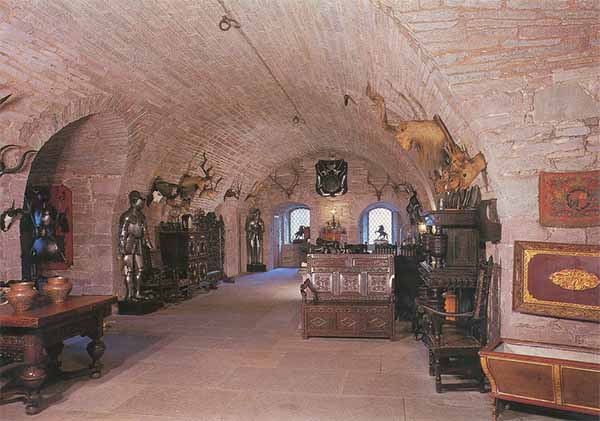Inside Glamis Castle : History, Macbeth & Ghost Lores

The idea of mystery in Scotland immediately evokes old haunted castles and ghost stories. And of all the legends in Scottish lore, the medal for Scotland’s most infested castle undoubtedly goes to Glamis Castle, because of the sinister "curse of the Strathmore" that hangs over it.
Glamis Castle history
It all started in 1372 when Robert II of Scotland, the king who later founded the Stuart dynasty, donated the castle to Sir John Lyon. But a bloodstain on the pavement just outside the castle entrance reminds us that here, in 1034, King Malcolm II was savagely cut in two with a claymore, the Scottish two-handed sword. No one has ever been able to remove the stain that may have inspired Oscar Wilde's short story The Canterville Ghost.
The Ghost of Earl Beardie
But the most famous ghost of Glamis is the ghost of Earl Beardie. Legend has it that on Sunday Lord Beardie finding no one to play cards with (indeed it was forbidden by the Scottish Church to play cards on the Lord's Day) and after mistreating several servants, yelled that he would even play "with the devil in person until Judgment Day." It was then that a stranger came to the castle and asked to play cards. The two locked themselves in a room and no one ever heard anything about Earl Beardie or the mysterious host again. Yet the inhabitants of the Glamis Castle swear to hear strange howls and the thudding of the dice on some nights. And many are convinced that they have encountered the eternally tormented spirit of Lord Beardie with gambling.
Shakespeare’s Macbeth
Glamis is also the castle where William Shakespeare's Macbeth is located: the place where the general, the hero, allegedly killed King Duncan. But Macbeth is also the most feared tragedy - superstitiously - of theater companies around the world who only use the phrase "the Scottish tragedy" so they never have to say its name explicitly. Indeed, its performances were struck by several misfortunes: 22 spectators died, in 1849, during the disorders caused by the representation in New York; in 1930, three decorators and costume designers died in a production; in 1948, an actress who played Lady Macbeth, during the sleepwalking scene, fell from a height of 5 meters. Each production inevitably has its share of incidents and failures: sudden illnesses of the actors, falls of the sets, real injuries by stage weapons, fires of all the electrical installations. It is as if the prophecies of witches imagined by Shakespeare cast a sinister shadow even outside the text.

Lady Glamis and the Grey Lady
It was precisely witchcraft that Janet Douglas, Lady Glamis was accused in 1537. The castle was requisitioned by King James V and Lady Glamis was burnt at the stake. The charges were subsequently turned out to be false and the castle was returned to the family, but it seems that since then the ghost of the Lady Glamis - the Grey Lady - has frequently appeared to the castle’ visitors. The family chapel attached to Glamis Castle can accommodate 46 people; one of those seats is still reserved for the Grey Lady, and no one, even today, dares to occupy it.
The White Lady
There is yet another female presence that many visitors for centuries, but also exceptional witnesses such as the sister of the Queen Mother of England, born precisely in Glamis, swear to have met along the corridors of Glamis Castle: the White Lady. Its history is not known, but the different colors attributed to the two old ladies reflect the intensity of their supposed appearances: the grey lady, more effaced, sadder and intangible, and the white lady, more lively, more aggressive and more radiant.
More facts and legends

But beyond these possible influences, the history of the inhabitants of Glamis Castle is marked by many disastrous events. The most terrible undoubtedly concern Earl Patrick Strathmore. During a war between the Lindsay clan and the Ogilvy clan, it was this depraved and cruel man that the latter sought asylum. Unable to refuse them hospitality, he would have welcomed them, but then walled them up in a secret room where they would have died of hunger and deprivation after devouring each other. Even today, one would hear complaints coming from inaccessible parts of the castle. And another disturbing legend hangs over this same Patrick who would have kept locked up, all his life, in another room of the castle, a son born with too much hair and deformities never revealed; he is called the monster of Glamis and he is also referred to in connection with repeated appearances. For centuries, clients and researchers have searched for the castle's secret rooms. At a famous reception, guests were asked to hang a cloth at every window they would have had the opportunity to meet. When they gathered outside the castle, they noticed that there were indeed seven windows (but in other versions of the story there were two or eleven) on which no fabric was floating: a convincing clue of the existence of secret rooms.
Today, the castle is open to the public: it can be visited, and, for the bravest, you can spend the night there. Mystery lovers may even decide to celebrate their wedding here under the age-old “curse of the Strathmores”.









































































































































































































































































































































